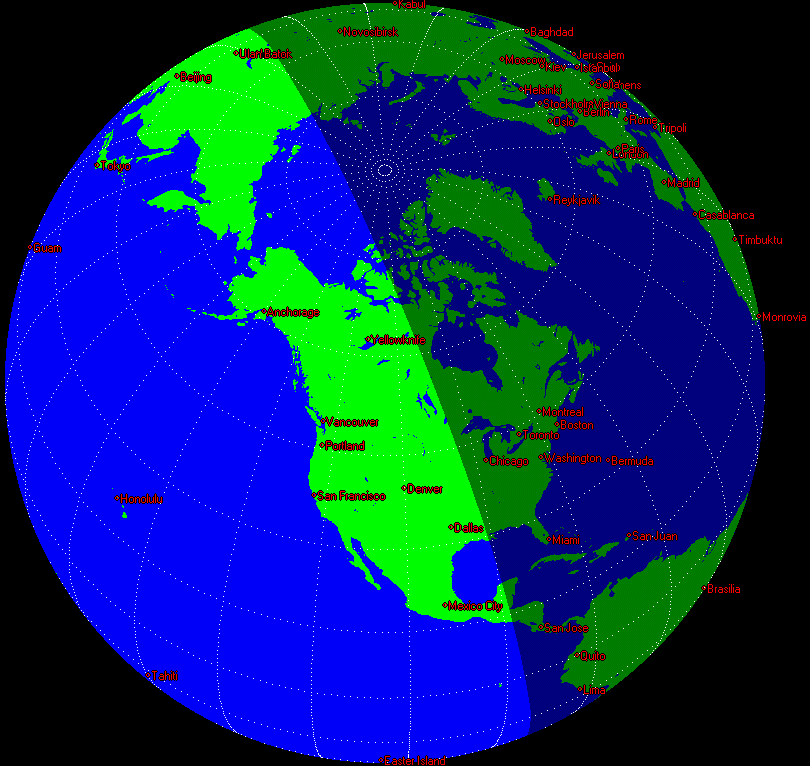Draconids 2018: prediction of activity
to the list of predictions

Fig. 1. Space-temporal projection of Draconid trails parts onto their minimal distance passages in 2018 (correspondence between colours of the particles and their ejection velocities can be seen here).
In 2018 the comet 21Р/Giacobini-Zinner passes its perihelion just a month before Draconids maximum. Also, the distance between the comet and the Earth orbits will be only 0.0171 AU, according to our computations. Nevertheless, despite such a promising geometry, modelling of Draconid trails evolution shows that no significant activity is expected, as the trails mostly pass too far from the Earth. The most close will be 1959 trail, however it will still pass as quite significant distance of 0.00249 AU, and moreover encountered part of this trail will be quite rarified due to encounter to the Earth in the past. So far we expect so activity from this trail, but very limited, with ZHR of 10-15 and with computed time of maximum at 23:34 UT on 8 October.
Anyways, in case of flashing showers, like Draconids, any cases of activity, even very small, are notable events as in most years such showers are completely or almost inactive. Also some unexpected activity bursts are always possible, especially close to the parent comet perihelia. Therefore the shower is very recommended for observations in 2018, especially around the given time of maximum from 1953 trail. In 2018 October the new Moon will be on 9 October, so the Moon won't create any problems for observations.

Fig. 3. The Earth as seen from coming Draconid meteors (RA=262.8°, Dec=+56.0°) during the expected maximum time of outburst from 1953 trail at 23:36 UT 8 October.
On the ground the best conditions for observations of this outburst would be in the north-easters end of Northern America (Labrador peninsula), in Greenland, British islands and Scandinavian peninsula. The radiant would also be reasonably high in the very north of Southern America. The observations would also be possible (though with low radiant elevation) in the north-western part of Russia, to the longitude of Novosibirsk (shown on the visibility map).
References
1. "Comet's dust 2.0" program by S. Shanov and S. Dubrovsky. [Used for orbital computations.]
2. Lyytinen E, van Flandern T. "Predicting the strength of Leonid outbursts", 2000, Icarus, P. 158-160.
3. Jenniskens P. Meteor showers and their parent comets, 2006, 780 p. 4. Kasuo Kinoshita, http://jcometobs.web.fc2.com/ [Orbital elements of the comet 8P Tuttle]
5. Hewgill G. Xearth 1.1.0 (Software program), 2003. 6. Molau S. Results of the IMO Video Meteor Network – December 2014. http://www.imonet.org/reports/201412.pdf 7. 2016 Meteor Shower Calendar, http://imo.net/files/data/calendar/cal2016.pdf
References
1. "Comet's dust 2.0" program by S. Shanov and S. Dubrovsky. [Used for orbital computations.]
2. Lyytinen E, van Flandern T. "Predicting the strength of Leonid outbursts", 2000, Icarus, P. 158-160.
3. Jenniskens P. Meteor showers and their parent comets, 2006, 780 p. 4. Kasuo Kinoshita, http://jcometobs.web.fc2.com/ [Orbital elements of the comet 8P Tuttle]
5. Hewgill G. Xearth 1.1.0 (Software program), 2003. 6. Molau S. Results of the IMO Video Meteor Network – December 2014. http://www.imonet.org/reports/201412.pdf 7. 2016 Meteor Shower Calendar, http://imo.net/files/data/calendar/cal2016.pdf